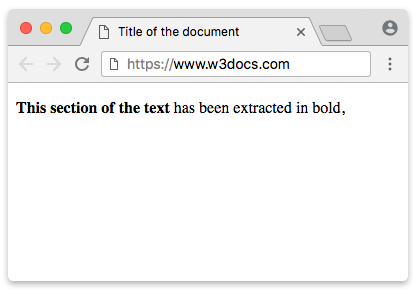The HTML<b> tag is used to highlight in bold that part of the text, which we want to make more obvious for the user. The <b> tag only highlights the part of the text, it has no semantic load (including for search engines).
Avoid using the <b> tag for titles and headings.Instead, you can use the <h1> - <h6> tags. It’s preferable to use this tag for marking keywords, product names or other spans of the text.
Syntax
The <b> tag comes in pairs. The content is written between the opening (<b>) and closing (</b>) tags.
Example of the HTML <b> tag:
<!DOCTYPE html>
<html>
<head>
<title>Title of the document </title>
</head>
<body>
<p><b>This section of the text </b> has been extracted in bold,</p>
</body>
</html>Result

The appearance of the content of the <b> container is defined by default, but the bold style can be changed by the help of CSS.
The CSS font-weight property also can be used to set bold text.
Example of the font-weight property for making the text bold:
<!DOCTYPE html>
<html>
<head>
<title>Title of the document </title>
<style>
.bold-text {
font-weight: 700;
}
</style>
</head>
<body>
<p>
<span class="bold-text">This section of the text </span>
has been extracted in bold.
</p>
</body>
</html><b> vs <strong>
Both the <b> and <strong> elements render the text in a bold typeface. The difference between them is that the <strong> tag stands for a text of a certain importance, but the <b> tag contain any information about the text. However, it’s better to avoid the <b> tag. Instead, you can use the "bold" value of the CSS font-weight property.
Attributes
The <b> tag supports the Global Attributes and the Event Attributes.
How to style <b> tag?
Common properties to alter the visual weight/emphasis/size of text in <b> tag:
- CSS font-style property sets the style of the font. normal | italic | oblique | initial | inherit.
- CSS font-family property specifies a prioritized list of one or more font family names and/or generic family names for the selected element.
- CSS font-size property sets the size of the font.
- CSS font-weight property defines whether the font should be bold or thick.
- CSS text-transform property controls text case and capitalization.
- CSS text-decoration property specifies the decoration added to text, and is a shorthand property for text-decoration-line, text-decoration-color, text-decoration-style.
Coloring text in <b> tag:
- CSS color property describes the color of the text content and text decorations.
- CSS background-color property sets the background color of an element.
Text layout styles for <b> tag:
- CSS text-indent property specifies the indentation of the first line in a text block.
- CSS text-overflow property specifies how overflowed content that is not displayed should be signalled to the user.
- CSS white-space property specifies how white-space inside an element is handled.
- CSS word-break property specifies where the lines should be broken.
Other properties worth looking at for <b> tag:
- CSS text-shadow property adds shadow to text.
- CSS text-align-last property sets the alignment of the last line of the text.
- CSS line-height property specifies the height of a line.
- CSS letter-spacing property defines the spaces between letters/characters in a text.
- CSS word-spacing property sets the spacing between words.
Browser support
|
|
|
|
|
|
|---|---|---|---|---|
| ✓ | ✓ | ✓ | ✓ | ✓ |
Practice Your Knowledge
Quiz Time: Test Your Skills!
Ready to challenge what you've learned? Dive into our interactive quizzes for a deeper understanding and a fun way to reinforce your knowledge.